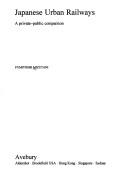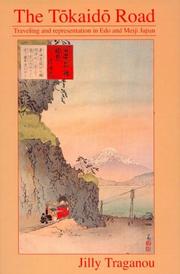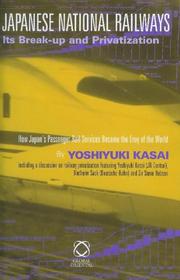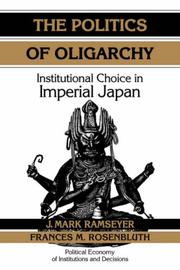| Listing 1 - 8 of 8 |
Sort by
|

ISBN: 185628980X Year: 1996 Publisher: Aldershot Avebury
Abstract | Keywords | Export | Availability | Bookmark
 Loading...
Loading...Choose an application
- Reference Manager
- EndNote
- RefWorks (Direct export to RefWorks)
Railway traffic --- Japan --- J4472 --- -Railroads and state --- -Denationalization --- Japan: Economy and industry -- transportation and infrastructure -- land --- -Japan: Economy and industry -- transportation and infrastructure -- land --- Local transit --- Railroads and state --- Railroads --- Iron horses (Railroads) --- Lines, Railroad --- Rail industry --- Rail lines --- Rail transportation --- Railroad industry --- Railroad lines --- Railroad transportation --- Railway industry --- Railways --- Communication and traffic --- Concessions --- Public utilities --- Transportation --- Trusts, Industrial --- City transit --- Mass transit --- Municipal transit --- Public transit --- Rapid transit --- Transit systems --- Urban transit --- Ridesharing --- Privatization

ISBN: 1134387490 1280155841 0203457978 9781134387496 9780203457979 0415310911 9780415310918 9786610155842 6610155844 9781280155840 9780415511148 9781134387441 9781134387489 1134387482 Year: 2004 Publisher: New York RoutledgeCurzon
Abstract | Keywords | Export | Availability | Bookmark
 Loading...
Loading...Choose an application
- Reference Manager
- EndNote
- RefWorks (Direct export to RefWorks)
The Tôkaidô Road offers a comparative study of the Tôkaidô road's representations during the Edo (1600-1868) and Meiji (1868-1912) eras. Throughout the Edo era, the Tôkaidô highway was the most important route of Japan and transportation was confined to foot travel. In 1889, the Tôkaidô Railway was established, at first paralleling and eventually almost eliminating the use of the highway. During both periods, the Tôkaidô was a popular topic of representation and was depicted in a variety of visual and literary media. After the installation of the railway in the Meiji era, the Tôkaidô
Communication and traffic --- Communications industries --- Mass communication --- Traffic --- Communication --- Transportation --- History. --- Tōkaidō (Japan) --- Japan --- Description and travel. --- History --- J3430 --- J4472 --- J4000.70 --- J4000.60 --- Japan: Geography and local history -- Chūbu region (Hokuriku, Kōshin'etsu, Tōkai) --- Japan: Economy and industry -- transportation and infrastructure -- land --- Japan: Social history, history of civilization -- Kindai (1850s- ), bakumatsu, Meiji, Taishō --- Japan: Social history, history of civilization -- Kinsei, Edo, Tokugawa period, early modern (1600-1867) --- Description and travel --- Tokaido (Japan)
Book
ISBN: 9781898823063 9781912961207 1912961202 1898823065 Year: 2011 Publisher: Folkestone, Kent Renaissance Books
Abstract | Keywords | Export | Availability | Bookmark
 Loading...
Loading...Choose an application
- Reference Manager
- EndNote
- RefWorks (Direct export to RefWorks)
A unique take on modern life in Tokyo, Japan's capital city. A Japan of trains, everyday to and fro, carriage scenes and theatre, vistas from the window, advertising posters. Each to be savoured through a specific Tokyo line - the Odakyu. Pitched as creative text and colour illustrations, 'Tokyo Commute' offers on-track and off-track observations. A gallery of mirrors, musings, memories. This is less documentary than iconography, a poetics of Japanese routine and etiquette. It offers a wry diary of month-and-weekday observations, a 'map' of Shinjuku as key station and gathering place, a run of notable Tokyo locations - from the national bunraku theatre to a Kawasaki sludge recycling centre. Other Odakyu travel involves the Hakone open air art gallery, Narita as both airport and temple-complex, Yokohama as history and Chinatown. Essential reading for first-time, and second-time, visitors, and even regular commuters.
Railroads --- Commuting --- J5590 --- J4472 --- Iron horses (Railroads) --- Lines, Railroad --- Rail industry --- Rail lines --- Rail transportation --- Railroad industry --- Railroad lines --- Railroad transportation --- Railway industry --- Railways --- Communication and traffic --- Concessions --- Public utilities --- Transportation --- Trusts, Industrial --- Telecommuting --- Social aspects --- Commuting traffic --- Japan: Literature -- foreign literature about Japan --- Japan: Economy and industry -- transportation and infrastructure -- land --- Odakyū Dentetsu Kabushiki Kaisha. --- Odakyū --- Odakyū Electric Railway Company --- 小田急電鉄株式会社 --- Tōkyō Kyūkō Dentetsu Kabushiki Kaisha --- Japan --- Social life and customs. --- Commuting traffic.

ISBN: 1901903451 900421397X Year: 2003 Publisher: Folkestone Global oriental
Abstract | Keywords | Export | Availability | Bookmark
 Loading...
Loading...Choose an application
- Reference Manager
- EndNote
- RefWorks (Direct export to RefWorks)
Railroads and state --- Privatization --- Chemins de fer --- Privatisation --- Politique gouvernementale --- Nihon Kokuyu Tetsudo. --- J4472 --- Japan: Economy and industry -- transportation and infrastructure -- land --- Nihon Kokuyū Tetsudō. --- Railroads --- Iron horses (Railroads) --- Lines, Railroad --- Rail industry --- Rail lines --- Rail transportation --- Railroad industry --- Railroad lines --- Railroad transportation --- Railway industry --- Railways --- Communication and traffic --- Concessions --- Public utilities --- Transportation --- Trusts, Industrial --- Chemins de fer nationaux du Japon --- J.N.R. --- Japan National Railways --- Japan. --- Japanese National Railways --- JNR --- Kokutetsu (Japan) --- 日本國有鐵道 --- 日本國有鉄道 --- 日本囯有鉄道 --- 日本国有鐵道 --- 日本国有鈇道 --- 日本国有铁道 --- 日本国有鉄道 --- Higashi Nihon Ryokaku Tetsudō Kabushiki Kaisha --- Nishi Nihon Ryokaku Tetsudō Kabushiki Kaisha --- Tōkai Ryokaku Tetsudō Kabushiki Kaisha --- Japanese Government Railways
Book
ISBN: 1421412675 9781421412672 9781421412665 1421412667 Year: 2014 Publisher: Baltimore
Abstract | Keywords | Export | Availability | Bookmark
 Loading...
Loading...Choose an application
- Reference Manager
- EndNote
- RefWorks (Direct export to RefWorks)
Railroads --- Railroad engineering --- World War, 1939-1945 --- Military engineering --- Iron horses (Railroads) --- Lines, Railroad --- Rail industry --- Rail lines --- Rail transportation --- Railroad industry --- Railroad lines --- Railroad transportation --- Railway industry --- Railways --- Communication and traffic --- Concessions --- Public utilities --- Transportation --- Trusts, Industrial --- Engineering, Railroad --- Transportation engineering --- Engineering, Military --- Civil engineering --- Engineering --- Military architecture --- Design and construction --- History --- Engineering and construction. --- Construction --- J4880.80 --- J7000.70 --- J4880.70 --- J4472 --- Engineering and construction --- Japan: Defense and military -- history -- Gendai (1926- ), prewar Shōwa period, WW II, 20th century --- Japan: Science and technology -- history -- Kindai (1850s- ), bakumatsu, Meiji, Taishō --- Japan: Defense and military -- history -- Kindai (1850s- ), bakumatsu, Meiji, Taishō --- Japan: Economy and industry -- transportation and infrastructure -- land --- World War (1939-1945)
Book
ISBN: 9789811016806 9811016801 981101681X Year: 2017 Publisher: [place of publication not identified] Palgrave Macmillan
Abstract | Keywords | Export | Availability | Bookmark
 Loading...
Loading...Choose an application
- Reference Manager
- EndNote
- RefWorks (Direct export to RefWorks)
This volume focuses on the topic of energy transitions in the coal mining industries of China and Japan by adopting a Sino-Japanese comparative approach in area studies to examine the experiences between the two major East Asian economies. In China, rapid industrialization led to dramatic growth in energy demand and much of this energy demand was fueled by affordable coal energy. With growing social concerns about the environment and an increasingly vocal middle class in contemporary China, the authorities and state-owned enterprises are studying the use of coal fuels for its future development. In Japan, coal was also an affordable main source of energy for Japan’s early post-war heavy industrialization until it was gradually replaced by oil in the 1960s. The oil shocks of the 1970s compelled Japan to look for cleaner and cheaper fuels, including nuclear power. In these energy transitions from coal to oil and then onto non-fossil fuels, the story of coal power in both countries is highlighted in this publication as a comparative study. This volume is a crucial contribution to the discussion of China's energy reforms, and required reading for scholars of climate change and society.
S10/0523 --- S10/0805 --- S10/0815 --- J4420 --- J4472 --- China: Economics, industry and commerce--Power supply (electricity, mining, oil) and computing industry --- China: Economics, industry and commerce--Transportation and communications: since 1949 --- China: Economics, industry and commerce--Railways: since 1949 --- Japan: Economy and industry -- resource industry --- Japan: Economy and industry -- transportation and infrastructure -- land --- Economic policy. --- Asia --- Economics. --- Economic Policy. --- Natural Resource and Energy Economics. --- Asian Economics. --- Economic nationalism --- Economic planning --- National planning --- State planning --- Economics --- Planning --- National security --- Social policy --- Economic conditions. --- Natural resources. --- Asia-Economic conditions. --- National resources --- Natural resources --- Resources, Natural --- Resource-based communities --- Resource curse --- Economic aspects --- Asia—Economic conditions. --- Power resources. --- Energy --- Energy resources --- Power supply --- Energy harvesting --- Energy industries
Book
ISBN: 9781350075931 9781350075948 9781350075955 1350075957 1350075965 1350075949 Year: 2019 Publisher: [London] : Bloomsbury Academic,
Abstract | Keywords | Export | Availability | Bookmark
 Loading...
Loading...Choose an application
- Reference Manager
- EndNote
- RefWorks (Direct export to RefWorks)
"Automobility and the City in Twentieth-Century Britain and Japan is the first book to consider how mass motorization reshaped cities in Japan and Britain during the 20th century. Taking two leading 'motor cities', Nagoya and Birmingham, as their principal subjects, Simon Gunn and Susan C. Townsend show how cars changed the spatial form and individual experience of the modern city and reveal the similarities and differences between Japan and Britain in adapting to the 'motor age'. The book has three main themes: the place of automobility in post-war urban reconstruction; the emerging conflict between the promise of mobility and personal freedom offered by the car and its consequences for the urban environment (the M/E dilemma); and the extent to which the Anglo-Japanese comparison can throw light on fundamental differences in cultural understanding of the environment, urbanism and the self. The result is the first comparative history of mass automobility and its environmental consequences between East and West."--Bloomsbury Publishing.
Road traffic --- Environmental planning --- Economic geography --- anno 1940-1949 --- anno 1950-1959 --- anno 1960-1969 --- anno 1970-1979 --- Great Britain --- Japan --- City planning --- J6580 --- J4192 --- J4472 --- Cities and towns --- Civic planning --- Land use, Urban --- Model cities --- Redevelopment, Urban --- Slum clearance --- Town planning --- Urban design --- Urban development --- Urban planning --- Land use --- Planning --- Art, Municipal --- Civic improvement --- Regional planning --- Urban policy --- Urban renewal --- History --- Japan: Art and antiquities -- urban planning --- Japan: Sociology and anthropology -- communities -- urban groups, the city --- Japan: Economy and industry -- transportation and infrastructure -- land --- Government policy --- Management --- E-books --- Roads. --- Highways --- Roadways --- Thoroughfares --- Transportation --- Highway engineering --- Pavements --- Automobiles --- Urbanization --- Asian history| BIC --- Autos (Automobiles) --- Cars (Automobiles) --- Gasoline automobiles --- Motorcars (Automobiles) --- Motor vehicles --- Transportation, Automotive

ISBN: 0521473977 0521636493 1139174355 Year: 1995 Publisher: Cambridge Cambridge University press
Abstract | Keywords | Export | Availability | Bookmark
 Loading...
Loading...Choose an application
- Reference Manager
- EndNote
- RefWorks (Direct export to RefWorks)
In the latter-half of the nineteenth century and the first half of the twentieth century, Japan underwent two major shifts in political control. In the 1910s, the power of the oligarchy was eclipsed by that of a larger group of professional politicians; in the 1930s, the focus of power shifted again, this time to a set of independent military leaders. In this book, Ramseyer and Rosenbluth examine a key question of modern Japanese politics: why the Meiji oligarchs were unable to design institutions capable of protecting their power. The authors question why the oligarchs chose the political institutions they did, and what the consequences of those choices were for Japan's political competition, economic development, and diplomatic relations. Indeed, they argue, it was the oligarchs' very inability to agree among themselves on how to rule that prompted them to cut the military loose from civilian control - a decision that was to have disastrous consequences not only for Japan but for the rest of the world.
Bureaucracy --- Cotton textile industry --- Finance --- Railroads and state --- J4301 --- J4415 --- J4458 --- J4472 --- J4580 --- J4600.70 --- J4649 --- Government ownership of railroads --- Government regulation of railroads --- Nationalization of railroads --- Railroads --- Railroads, Nationalization of --- State and railroads --- State ownership of railroads --- Government ownership --- Transportation and state --- Railroad law --- Funding --- Funds --- Economics --- Currency question --- Textile industry --- History --- Government policy&delete& --- Japan: Economy and industry -- policy, legislation, guidelines, codes of behavior --- Japan: Economy and industry -- industrial organization and relations -- industry and state --- Japan: Economy and industry -- manufacturing and production -- textile and clothing --- Japan: Economy and industry -- transportation and infrastructure -- land --- Japan: Economy and industry -- finance -- public finance and taxes --- Japan: Politics and law -- history -- Kindai (1850s- ), bakumatsu, Meiji, Taishō --- Japan: Politics and law -- central government -- bureaucracy and civil servants --- Government policy --- Regulation --- State supervision --- Management --- Japan --- Politics and government --- Social Sciences --- Political Science --- History.
| Listing 1 - 8 of 8 |
Sort by
|

 Search
Search Feedback
Feedback About UniCat
About UniCat  Help
Help News
News